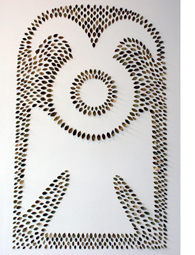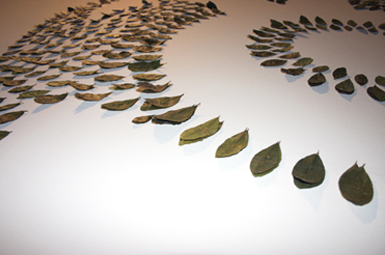  Coca Bird :: 2006 A wall installation containing several hundred coca leaves creating an image of an pre-Columbian bird symbol. FEATURED in COCQUITA: The coca plant’s importance lays in the essence of its sacred usages, as well as in daily life. Coca leaves occupy a central role in the region’s religious ceremonies. They are a significant component of the offerings and are arranged in two- and three-leaf formations representing, respectively, Pacha Mama (Quechua, mother-earth) and the Apu’s (Quechua, mountains). Meditative chewing of the leaf is also an important component of debate and decision-making in the social and political life of traditional Andean people. The coca leaf is a source of vitamins and calcium and is effective in reducing or eliminating altitude sickness by regulating pressure changes on the body common in these areas. Long hikes in rugged terrain where there is little or no transportation or provisions call for its use as a mild stimulant to control hunger and to supply greater physical resistance. The leaves are placed inside the mouth or taken as an infusion, and most recently, its consumption has extended to other forms such as flour, candy, and medicinal products. Coca’s recent chemical manipulation and subsequent trade as an illegal commodity have clouded its time-honored significance as both a ceremonial and practical element in traditional Andean cultures. |
|---|